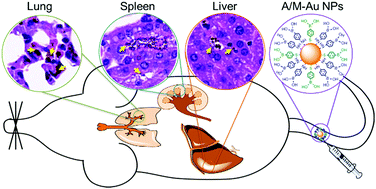Evaluation of the in vivo behavior of antibacterial gold nanoparticles for potential biomedical applications†
Abstract
The pharmacokinetics is a critical factor determining the clinical applicability of nanomaterials. Systematic study of the pharmacokinetics of functional nanomaterials is thus significant for promoting their applications. Herein, we take aminophenylboronic acid and mercaptophenylboronic acid-co-modified gold nanoparticles (A/M-Au NPs) with potent and tunable antibacterial activity as an example to study their behaviors in vitro and in vivo. The maximum concentration (Cmax, 2 mg L−1), the time to reach the maximum concentration (Tmax, 6 h), and the half-life (T1/2, 12 h) in the plasma of mice reflect appropriate pharmacokinetics of the gold nanoparticles as an ideal nano-antibiotic. Strikingly, the A/M-Au NPs show an extremely high median lethal dose (920 mg kg−1), which is about 100 times their effective dose (7.2 mg kg−1), suggesting their outstanding biosafety. The adequate pharmacokinetic profile and the high biosafety of the gold nanoparticles pave the way for their potential biomedical applications.

- This article is part of the themed collection: Celebrating International Women’s Day: Women in Materials Science


 Please wait while we load your content...
Please wait while we load your content...